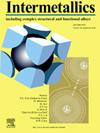Effect of Nb addition in novel amorphous/nanocrystalline Ti-Zr-Cu-Ni-Nb brazing fillers on improving microstructure and mechanical properties of TiAl alloy joints
IF 4.3
2区 材料科学
Q2 CHEMISTRY, PHYSICAL
引用次数: 0
Abstract
For high-strength brazing of TiAl alloys, novel amorphous/nanocrystalline Ti45Zr25Cu15Ni15, Ti45Zr25Cu10Ni15Nb5, and Ti45Zr25Cu10Ni10Nb10 (at%) alloys (denoted as Nb0, Nb5, and Nb10, respectively) were designed and synthesized in a melt-spun ribbon form as the brazing filler metals (BFMs). With the increase of Nb content in the Ti-Zr-Cu-Ni(-Nb) alloys, the glass-forming ability exhibited a decreasing trend, while continuous and flexible BFM ribbons with a thickness up to 40 μm could still be obtained since the amorphous phase serves as the matrix of the ribbons. The effect of Nb addition in Ti-Zr-Cu-Ni(-Nb) BFMs on the microstructure and mechanical properties of TiAl alloy joints was investigated. By using the Ti-Zr-Cu-Ni(-Nb) BFMs, the resultant joints brazed at 1223 K for 30 min exhibited the microstructure consisting of α2-Ti3Al and (Ti, Zr)2(Cu, Ni) as the matrix and different precipitated phases at the center of the braze zones. For the joints brazed with the Nb0 and Nb5 BFMs, the precipitated phases were α2-Ti3Al + α-Ti with an island-like morphology. By contrast, in the joint brazed with the Nb10 BFM, the precipitated phases were the almost continuous B2 + O-Ti2AlNb, and the fraction of the brittle (Ti, Zr)2(Cu, Ni) phase was reduced. Due to the improved microstructure, by using the Nb10 amorphous/nanocrystalline BFM ribbon, high shear strength up to ∼236 MPa was achieved for the TiAl alloy joint brazed at the relatively-low brazing temperature. It is indicated that the addition of Nb in the Ti-based BFMs is effective in improving the microstructure and strength of the TiAl brazed joints.
在新型非晶/纳米晶 Ti-Zr-Cu-Ni-Nb 铜焊填料中添加 Nb 对改善 TiAl 合金接头微观结构和机械性能的影响
本文章由计算机程序翻译,如有差异,请以英文原文为准。
求助全文
约1分钟内获得全文
求助全文
来源期刊

Intermetallics
工程技术-材料科学:综合
CiteScore
7.80
自引率
9.10%
发文量
291
审稿时长
37 days
期刊介绍:
This journal is a platform for publishing innovative research and overviews for advancing our understanding of the structure, property, and functionality of complex metallic alloys, including intermetallics, metallic glasses, and high entropy alloys.
The journal reports the science and engineering of metallic materials in the following aspects:
Theories and experiments which address the relationship between property and structure in all length scales.
Physical modeling and numerical simulations which provide a comprehensive understanding of experimental observations.
Stimulated methodologies to characterize the structure and chemistry of materials that correlate the properties.
Technological applications resulting from the understanding of property-structure relationship in materials.
Novel and cutting-edge results warranting rapid communication.
The journal also publishes special issues on selected topics and overviews by invitation only.
 求助内容:
求助内容: 应助结果提醒方式:
应助结果提醒方式:


